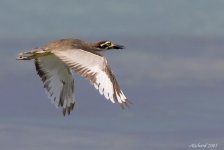RMD said:
Thanks Steve,
As a new user of the forum I'm still having a hard time comming to grips with the same bird having different scientific names, common names no problem.
A search in the database shows neither Beach Thick-knee nor Burhinus giganteus.
Steve, your recommendation please?
Attached is a "wings down" photo, again from today.
Richard
Richard, your bird is obviously a Beach Thick-knee (or Beach Stone-curlew). As the Database is presently it would have to go in under the slot for Esacus neglectus.
The problem is basically the use of differing taxonomy and nomenclature according to the various world and regional lists for the two birds that I had mentioned - Great Thick-knee (Stone-curlew) and Beach Thick-knee (Stone-curlew).
Taxonomy Note:
Sibley-Monroe 1996 (the one used in this Database)
Great Thick-knee - Burhinus recurvirostris
Beach Thick-knee - Esacus neglectus
Clement's 5° Ed. (updated 2005)
Great Thick-knee - Burhinus recurvirostris
Beach Thick-knee - Burhinus magnirostris
Howard & Moore 3° Ed. (updated 2004)
Great Stone Curlew - Esacus recurvirostris
Beach Stone Curlew - Esacus magnirostris
Sibley-Monroe (2003) (this is what is should be in the Database if it were current)
Great Thick-knee - Burhinus recurvirostris
Beach Thick-knee - Burhinus giganteus (your bird)
As you can see there is quite a bit of discord regarding the classification and taxonomy of these two large closely-related Thick-knees.
What should be done is for one of the Moderators (you can contact by PM) that has required access and possibility for changing the Database entries, to delete the present slot for Beach Thick-knee (Esacus neglectus), and to create the slot Beach Thick-knee (Burhinus giganteus). I would do it myself but I don't have the necessary access to the Database for this type of modification.






